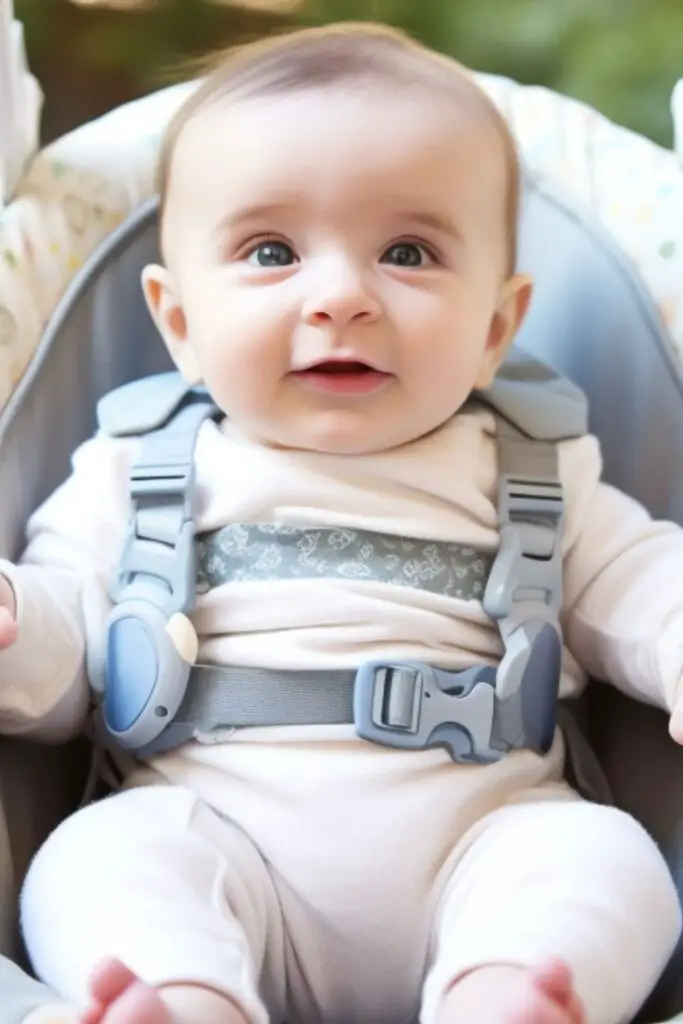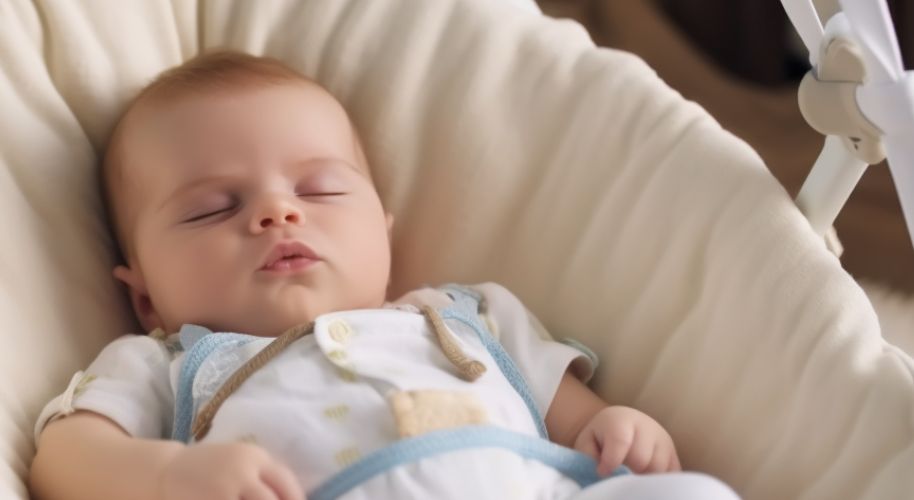Last Updated on June 5, 2025
In parenting, few things are as enchanting as watching your little one drift into dreamland. But sometimes, getting them there can be a challenge. This is where baby swings come into play, offering a soothing, rhythmic motion that mimics the comforting environment of the womb.
But are there any baby swings that are suitable for sleep? The answer is yes, there are. Baby swings have been ingeniously designed with multiple features to ensure your baby’s comfort and safety, allowing them to fall asleep peacefully.
They come with varying speeds, soothing music, and plush, comfortable seats, making it an ideal sleeping spot for your baby.it’s essential to remember that while baby swings can be a helpful tool for napping, they should not replace a crib or bassinet for overnight sleep due to safety considerations. Let’s explore this topic further and explore some of the best baby swings you can use for nap time.

Is it safe for babies to sleep in a swing?
While baby swings have been a popular tool for parents to soothe their babies, their safety for sleep has been a topic of discussion. Experts advise against allowing babies to sleep in a swing. Sleeping in swings has been linked to higher risks of injury and flat spots on the baby’s head.
A baby swing can be safe, but only when used properly. The American Academy of Pediatrics (AAP) also recommends moving your baby from the swing to a safe sleeping place if they fall asleep in the swing.
Why aren’t baby swings considered safe for sleep?
Baby swings, while providing a soothing motion that can calm fussy babies, are not considered safe for sleep due to several reasons:
Risk of Injury and Flat Spots:
According to the Sleep Foundation, sleeping in baby swings has been linked to higher risks of injury and flat head spots.
Blocked Airways and Accidental Suffocation:
The position in which a baby sleeps in a swing may block their airways, leading to accidental suffocation.
Not Designed for Sleep:
Swings are not designed for overnight sleep or even napping. They lack the safety features found in cribs and bassinets.
Supervision Required:
Swings are meant to be used recreationally under a caretaker’s supervision. Leaving a baby unsupervised in a swing can lead to dangerous situations.
AAP Guidelines:
The American Academy of Pediatrics (AAP) strongly discourages using swings as infant sleeping environments. Unlike cribs or bassinets, swings lack the essential design elements necessary to ensure safe sleep for babies. Swings often position infants at an incline, potentially leading to blocked airways and compromised breathing. Additionally, swings may not provide the proper support for a newborn’s developing spine and neck muscles, increasing the risk of discomfort or potential injury. Parents must prioritize cribs or bassinets that adhere to established safety standards, offering a flat and firm sleep surface that promotes healthy sleep and reduces the risk of Sudden Infant Death Syndrome (SIDS).
Weak Neck Muscles:
Babies, especially those under four months old, have weak neck muscles and may be unable to support their heads in a swing.
Unsafe Sleep Environment:
Baby sleep environments should be firm, flat, and free of soft bedding or toys. Swings do not meet these criteria.
You Might also Like These Resources!
- Is Supervised Sleep in a Swing Safe for Babies?
- Is Overnight Sleep in a Mamaroo Swing Safe for Babies?
- Duration of Baby Sleep in a Swing: What’s Safe?
What are the safe sleeping practices for babies?

Safe sleeping practices for babies are crucial to prevent risks such as Sudden Infant Death Syndrome (SIDS), choking, and suffocation. Here are some of the recommended practices according to various reliable sources:
Back Sleep Position:
Always place your baby on their back to sleep. This is the safest position to reduce the risk of SIDS.
Firm Sleep Surface:
Use a firm, flat sleep surface, such as a mattress in a safety-approved crib covered by a fitted sheet. Avoid soft bedding, comforters, pillows, loose sheets, or blankets.
Room Sharing:
The AAP recommends room-sharing with your baby but advises against bed-sharing. Keeping your baby’s crib in your room close to your bed can help you monitor them more closely.
Eliminate Hazards:
Keep loose blankets, pillows, bumper pads, and soft toys out of the baby’s sleep area to avoid the risk of suffocation and strangulation.
Avoid Overheating:
Dress your baby to room temperature, and don’t over-bundle. Babies should not feel hot to the touch.
Smoke-Free Environment:
Ensure your baby’s environment is smoke-free during pregnancy and after birth.
Avoid Sleep in Seating Devices:
Babies should not be allowed to sleep on a couch or armchair or in a seating device like a swing or car safety seat except while riding in the car.
How can a baby’s habit of sleeping in a swing be broken?
Breaking a baby’s habit of sleeping in a swing may require patience, consistency, and gentle methods. Here are some steps you can take:
Gradual Transition:
Start by reducing the time your baby spends in the swing each day. This gradual decrease can make the transition easier for both of you.
Substitute Motion:
Babies often enjoy the motion of a swing. You can substitute this with other forms of movement, like rocking them in your arms, using a baby carrier, or using a stroller for naps.
Establish a Routine:
Consistency is key when breaking habits. Establish a sleep routine that includes a warm bath, reading a book, or singing lullabies before placing your baby in their crib or bassinet.
Create a Comfortable Environment:
Ensure the baby’s sleep environment is comfortable, quiet, and dark. Using white noise machines can also recreate the soothing hum of a swing.
Swaddle Your Baby:
Swaddling can help newborns feel secure and prevent them from startling awake. Always ensure that swaddling is done safely.
Be Patient:
Remember, it might take time for your baby to adjust to this new routine. Be patient and provide comfort as needed.
Seek Professional Help:
If your baby is having difficulty adjusting, consider seeking help from a pediatrician or a certified sleep consultant.
What are the alternatives for babies to sleep other than swing?
While swings can soothe and entertain babies, they are not the safest option for sleep. Here are some alternatives:
Crib or Bassinet:
These are the safest places for a baby to sleep. They provide a flat, firm surface that reduces the risk of SIDS.
Pack ‘n Play:
Also known as playards, these offer babies a safe and portable sleeping environment.
Bedside Sleeper:
These attach to the parent’s bed, allowing easy access to the baby during the night while providing a separate sleep space.
Baby Box:
A newer trend, these cardboard boxes come with a firm mattress and fitted sheet. They’re portable and designed to be a safe sleep space for babies.
Co-sleeper Cot:
These cots attach to your bed, allowing you to keep your baby close while maintaining a separate sleeping area.
Baby Lounger:
While not recommended for unsupervised sleep, loungers can provide a cozy spot for supervised naps.
Baby Hammock:
Some parents find these helpful for babies who prefer a bit of movement while they sleep. However, they should be used with caution and under supervision.
Moses Basket:
These are portable, lightweight, and perfect for newborns. Ensure it has a firm mattress and no extra bedding.
FAQs
What are the dos and don’ts for safe sleep in babies?
Ensuring safe sleep for babies is crucial to prevent risks such as Sudden Infant Death Syndrome (SIDS). Here are some dos and don’ts for safe baby sleep:
Dos:
Back Sleep Position:
Always place your baby on their back to sleep. This is the safest position to reduce the risk of SIDS.
Use a Firm Sleep Surface:
Your baby should sleep on a firm, flat surface like a safety-approved crib mattress covered by a fitted sheet.
Keep the Crib Clear:
The crib should be free from stuffed animals, blankets, pillows, bumper pads, or sleep positioners.
Room Sharing:
Sharing a room with your baby is recommended but different from the same bed. Keep your baby’s crib or bassinet near your bed for ease of feeding and monitoring.
Offer a Pacifier:
If breastfeeding is established, offering a pacifier at nap or bedtime may reduce the risk of SIDS.
Ensuring safe sleep for babies is crucial to prevent risks such as Sudden Infant Death Syndrome (SIDS). Here are some dos and don’ts for safe baby sleep:
Dos:
Back Sleep Position:
Always place your baby on their back to sleep. This is the safest position to reduce the risk of SIDS.
Use a Firm Sleep Surface:
Your baby should sleep on a firm, flat surface like a safety-approved crib mattress covered by a fitted sheet.
Keep the Crib Clear:
The crib should be free from stuffed animals, blankets, pillows, bumper pads, or sleep positioners.
Room Sharing:
Sharing a room with your baby is recommended but different from the same bed. Keep your baby’s crib or bassinet near your bed for ease of feeding and monitoring.
Offer a Pacifier:
If breastfeeding is established, offering a pacifier at nap or bedtime may reduce the risk of SIDS.
Don’ts:
Avoid Soft Surfaces:
Keep your baby from sleeping on soft surfaces like adult beds, sofas, or chairs.
No Bed Sharing:
Bed sharing can increase the risk of SIDS and accidental suffocation.
Avoid Inclined Sleepers or Positioners:
Any sleeper or positioner that inclines more than 10 degrees is unsafe for sleep.
Smoke-Free Environment:
Avoid smoking during pregnancy and keep your baby’s environment smoke-free after birth.
Can a baby safely sleep in a swing throughout the night?
It’s not safe for babies to sleep in a swing throughout the night. The American Academy of Pediatrics (AAP) advises against using swings for sleeping babies. “Infants haven’t developed their muscles enough to hold up their heads. Babies easily fall,” states (AAP).
Swings aren’t designed for sleep as newborns lack the muscle strength and coordination to keep their heads properly positioned, which could make it difficult for them to breathe. Safe sleep experts have deemed babies staying asleep in this position risky.
“Babies — especially those under four months old — have weak neck muscles and can’t control their heads well. Letting your baby sleep all night in a swing can be dangerous,” warn experts.
Wrapping up
Swings can be a great way to soothe and entertain babies; they should not be used as a place for sleep. Following safe sleep practices is important to reduce the risk of SIDS and accidental suffocation.
Parents should always ensure their baby sleeps on a flat, firm surface in their crib or bassinet. If you have any questions or concerns, seek help from a pediatrician or certified sleep consultant.
With these tips and resources, you can create the safest sleeping environment for your baby.
You Might Also Like These Latest Content!
- The Benefits of Swings for Babies with Reflux
- Permissible Use of Mini Baby Swings in Day Care Centers
- Step-by-Step Guide: Assembling Your Mamaroo

Dr. Leah Alexander is a board-certified general pediatrician who has been in practice for over 20 years. She began working as a pediatrician at Elizabeth Pediatric Group of New Jersey in 2000. Since 2005, she has been working as an independently contracted pediatrician with Medical Doctors Associates at Pediatricare Associates of New Jersey. Read more
